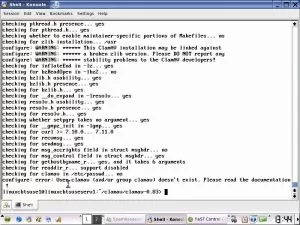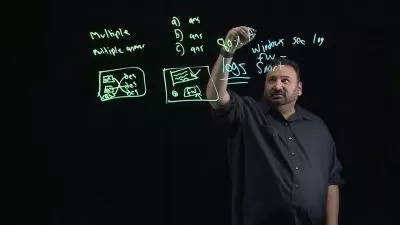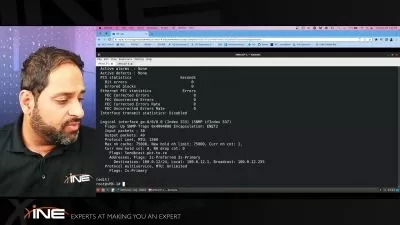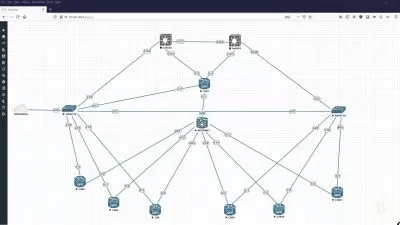Complete Intro to Telecom Networking and Structured Cabling
Hofmeyr de Vos
11:33:42
Description
Master telecom networking & cabling: From fundamentals to practical skills. Boost your career now! #StructuredCabling
What You'll Learn?
- Understand the fundamentals of telecommunications and networking
- Master structured cabling standards and best practices
- Identify different types of cabling and their applications
- Learn cable installation techniques
- Explore cable testing and troubleshooting methodologies
- Comprehend cable management and labeling strategies
- Apply knowledge in real-world scenarios
Who is this for?
What You Need to Know?
More details
DescriptionStep into the world of telecommunications and computer networking with our comprehensive course on "Complete Intro to Telecom Networking and Structured Cabling." Whether you're an aspiring network technician or a seasoned IT professional looking to expand your skill set, this course is designed to provide you with a solid foundation in structured cabling.
Structured cabling serves as the backbone of modern networks, ensuring seamless data transmission and connectivity. In this course, you'll delve into the essential concepts of telecommunications and networking, understanding the OSI model, TCP/IP, and Ethernet protocols.
Master industry-standard cabling specifications, such as TIA/EIA 568, and learn best practices for planning, designing, and implementing structured cabling systems. Identify different types of cables, from twisted-pair copper cables to fiber optics, and discover their specific applications.
Through hands-on demonstrations, you'll gain practical experience in cable installation and termination techniques, ensuring efficiency and reliability in your network infrastructure. Learn to use cable testers and troubleshoot common issues to maintain optimal performance.
Furthermore, you'll explore cable management and labeling strategies, creating an organized and easily maintainable network environment.
Whether you're pursuing a career in networking or seeking to upgrade your knowledge, this course equips you with the essential skills to succeed in the dynamic world of telecom networking. Enroll now and unlock the potential of structured cabling for your professional journey!
The learning objectives in detail :
Understand the fundamentals of telecommunications and networking: Students will gain a solid foundation in the principles and concepts of telecommunications and computer networking, including the OSI model, TCP/IP, and Ethernet.
Master structured cabling standards and best practices: Learners will become familiar with industry-standard cabling specifications, such as TIA/EIA 568, and learn best practices for planning, designing, and implementing structured cabling systems.
Identify different types of cabling and their applications: Participants will be able to distinguish between various types of cables, including twisted-pair copper cables (Cat5e, Cat6, etc.), fiber optic cables, and coaxial cables, and understand their specific use cases.
Learn cable installation techniques: Students will be trained in the proper techniques for installing and terminating different types of cables, ensuring efficient and reliable connectivity.
Explore cable testing and troubleshooting methodologies: Learners will gain proficiency in using cable testers and learn how to troubleshoot common issues in structured cabling systems, ensuring optimal performance.
Comprehend cable management and labeling strategies: Participants will understand the importance of cable management and labeling to maintain a well-organized and easily maintainable network infrastructure.
Apply knowledge in real-world scenarios: Through practical exercises and case studies, students will apply their understanding of structured cabling concepts to real-world scenarios, preparing them for hands-on work in the field of telecommunications networking.
These learning objectives will guide the students through the course, providing a clear direction on what they will achieve and learn upon completion.
Who this course is for:
- Aspiring network technicians and IT professionals seeking to enter the field of telecommunications and networking.
- Current IT professionals or network administrators looking to expand their skillset and knowledge in structured cabling.
- Students pursuing degrees or certifications in computer networking, telecommunications, or related fields.
- Individuals interested in understanding the backbone of modern networks and the principles behind structured cabling.
- Anyone aiming to enhance their expertise in cable installation, testing, troubleshooting, and network maintenance.
Step into the world of telecommunications and computer networking with our comprehensive course on "Complete Intro to Telecom Networking and Structured Cabling." Whether you're an aspiring network technician or a seasoned IT professional looking to expand your skill set, this course is designed to provide you with a solid foundation in structured cabling.
Structured cabling serves as the backbone of modern networks, ensuring seamless data transmission and connectivity. In this course, you'll delve into the essential concepts of telecommunications and networking, understanding the OSI model, TCP/IP, and Ethernet protocols.
Master industry-standard cabling specifications, such as TIA/EIA 568, and learn best practices for planning, designing, and implementing structured cabling systems. Identify different types of cables, from twisted-pair copper cables to fiber optics, and discover their specific applications.
Through hands-on demonstrations, you'll gain practical experience in cable installation and termination techniques, ensuring efficiency and reliability in your network infrastructure. Learn to use cable testers and troubleshoot common issues to maintain optimal performance.
Furthermore, you'll explore cable management and labeling strategies, creating an organized and easily maintainable network environment.
Whether you're pursuing a career in networking or seeking to upgrade your knowledge, this course equips you with the essential skills to succeed in the dynamic world of telecom networking. Enroll now and unlock the potential of structured cabling for your professional journey!
The learning objectives in detail :
Understand the fundamentals of telecommunications and networking: Students will gain a solid foundation in the principles and concepts of telecommunications and computer networking, including the OSI model, TCP/IP, and Ethernet.
Master structured cabling standards and best practices: Learners will become familiar with industry-standard cabling specifications, such as TIA/EIA 568, and learn best practices for planning, designing, and implementing structured cabling systems.
Identify different types of cabling and their applications: Participants will be able to distinguish between various types of cables, including twisted-pair copper cables (Cat5e, Cat6, etc.), fiber optic cables, and coaxial cables, and understand their specific use cases.
Learn cable installation techniques: Students will be trained in the proper techniques for installing and terminating different types of cables, ensuring efficient and reliable connectivity.
Explore cable testing and troubleshooting methodologies: Learners will gain proficiency in using cable testers and learn how to troubleshoot common issues in structured cabling systems, ensuring optimal performance.
Comprehend cable management and labeling strategies: Participants will understand the importance of cable management and labeling to maintain a well-organized and easily maintainable network infrastructure.
Apply knowledge in real-world scenarios: Through practical exercises and case studies, students will apply their understanding of structured cabling concepts to real-world scenarios, preparing them for hands-on work in the field of telecommunications networking.
These learning objectives will guide the students through the course, providing a clear direction on what they will achieve and learn upon completion.
Who this course is for:
- Aspiring network technicians and IT professionals seeking to enter the field of telecommunications and networking.
- Current IT professionals or network administrators looking to expand their skillset and knowledge in structured cabling.
- Students pursuing degrees or certifications in computer networking, telecommunications, or related fields.
- Individuals interested in understanding the backbone of modern networks and the principles behind structured cabling.
- Anyone aiming to enhance their expertise in cable installation, testing, troubleshooting, and network maintenance.
User Reviews
Rating
Hofmeyr de Vos
Instructor's Courses
Udemy
View courses Udemy- language english
- Training sessions 72
- duration 11:33:42
- Release Date 2023/11/14













